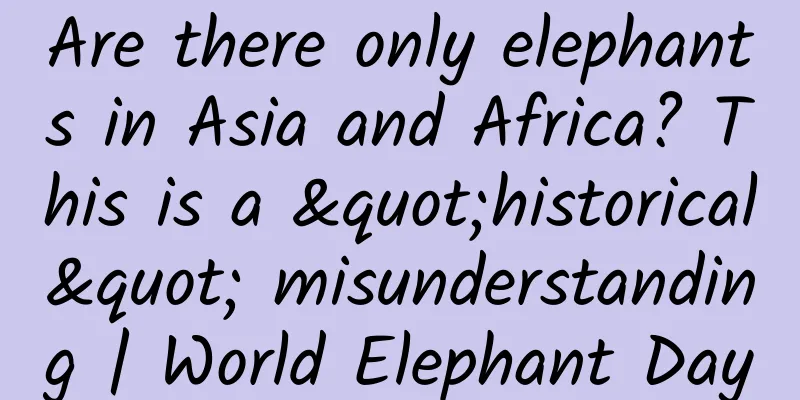Are there only elephants in Asia and Africa? This is a "historical" misunderstanding | World Elephant Day

|
If you were asked what is the largest land animal in the world today, you would probably answer without hesitation that it is the elephant. You might even go a step further and name the African elephant. Their huge figures may come to our minds, but when we try to recall information other than their shapes, we often find that we know very little about them. 01Elephant benchmark event: starting the journey of walking the earth There are three types of elephants in the world today, namely the African savanna elephant ( Loxodonta africana ), the African bush elephant ( Loxodonta cyclotis ) and the Asian elephant ( Elephas maximus ), and their names correspond to their distribution areas. Although their figures in the forests and grasslands are still magnificent today, they are already the afterglow of their glorious era. In biological taxonomy, elephants belong to the order Afrotheria of the class Mammalia, and as the name suggests, their origin is in Africa. Asian elephant (copyright image from the gallery, reprinting may cause copyright disputes) About 25 to 20 million years ago, ancient elephants began to move out of the Africa-Arabia region, known as the "proboscidean datum event". This was due to the rotation of the African and Arabian plates, which connected with the Eurasian continent to form a land bridge. From then on, elephants moved to a wider living space. By about 16 million years ago, elephants arrived in North America, and their living space was further expanded. Until about 8 million years ago, it was the golden age of elephant development. 02 Although they have gone their separate ways, they occasionally interbreed Later, global climate change led to the emergence of large areas of less productive, seasonal vegetation, which challenged the survival of elephants, especially those with primitive teeth. But at the same time, the ancestors of modern elephants adapted to these changes. A mammoth specimen restored in the Czech Krumlov Zoo (Photo source: Wikipedia commons) According to genomic analysis by Eleftheria Palkopoulou et al., the common ancestor of Asian elephants and mammoths separated from the ancestors of African elephants about 9 million to 4.2 million years ago; about 5 million to 2 million years ago, straight-tusked elephants ( Palaeoloxodon ) separated from African elephants first, and then the ancestors of African savanna elephants and African elephants separated, and almost at the same time, the ancestors of Asian elephants and mammoths also separated. However, in later days, there seemed to be some hybridization events between these elephants, which caused their evolutionary routes to occasionally cross each other. Restoration of the life scene of the straight-tusked elephant (Image source: Wikipedia commons) 03 The severely injured elephants and their last “territory” After that, elephants faced climate change and biome adjustments again and again, and their evolutionary potential was gradually consumed in the process. Obviously, the ice age that just ended brought unprecedented pressure. Starting about 160,000 years ago, elephants in Eurasia began to decline rapidly, and about 75,000 years ago, elephants in the Americas also began to become extinct rapidly. When humans left Africa and rose on various continents, they once again dealt a heavy blow to these giants. Today, there are no elephants in the Americas, and the elephants in Eurasia have been squeezed into a small area in tropical Asia. Only the elephants in Africa seem to be doing well, but in fact they are also in danger. The era of dozens of species living on the earth for nearly 20 million years has changed dramatically, and now there are only three species of elephants left. 04 The rock-solid “matriarchal clan” During the long evolution, elephants formed a complex society. The matriarchal clan of elephants is very stable, and its foundation is the family group, that is, the mother-child group. A mother-and-child herd usually consists of a female leader, her adult daughters, and all their underage offspring. The leader's sisters, cousins, etc. sometimes join the group. Although the leader of the group is usually the oldest female, this is not necessarily the case. If a female elephant is too old to lead the herd, the leader position will be replaced by another female elephant. The number of elephants in a group is usually around 10, but can reach more than 20. In rare cases, some female elephants will leave the existing group, form a new group and become the leader if they have followers. But in most cases, the group members are very stable, they move in unison, unite within 45 meters around the female leader, and advance and retreat together. A female Asian elephant and her cub in Yala National Park, Sri Lanka (Image source: Wikipedia commons) An elephant family in Amboseli National Park in Kenya, Africa (Image source: Wikipedia commons) Male elephants that have left the group due to adulthood will become wanderers, and sometimes they will form loose "male gangs", which are very unstable organizations. In the social interaction of males, there is also a clear hierarchy. The strongest male elephants tend to lead the entire group. They walk at the front of the team, occupy the best living position, and at the same time, intimidate any challengers; but experienced old male elephants are also respected, especially when the group migrates. A group of young single male elephants in Hwange National Park, Zimbabwe (Image source: Wikipedia commons) 05 Elephant Family "Cultural Heritage" Elephants have huge brains, and they are undoubtedly intelligent and emotional, and have a certain family "cultural heritage", at least in the field of zoology, there is such a term. Limor Raviv and others even believe that elephants are the third group to achieve self-domestication after humans and bonobos. The self-domestication hypothesis is a theory that has gradually been valued by the academic community in recent years. It is used to explain why humans have many extraordinary characteristics, such as sophisticated cultural and social dynamics, complex communication skills, and developed tool-using abilities. This theory holds that humans will choose less aggressive spouses or other social partners during the evolution process. This "self-selection" will give more pro-social individuals an advantage, resulting in more contacts and complex community structures, which will lead to the formation of complex languages and ultimately promote human cultural evolution. Asian elephants in Thailand (Image source: Wikipedia commons) Raviv and his colleagues used a small-print table that almost covered an A4 page to prove that elephant society has the same evolutionary characteristics, covering all aspects from physiology to behavior. They believe that the reasons for this kind of evolution may be extremely suitable or extremely harsh living environments. Coincidentally, elephants have experienced both of these living environments. 06 The Dilemma of the Behemoth Today, elephants and humans are in conflict over their interests. These conflicts often occur in areas where their living areas overlap. Elephants are frequent visitors to farmland, and they particularly like crops such as corn and rice. However, humans may drive elephants out of their homes for business activities, and poaching may directly kill elephants. The conflicts between humans and elephants are accumulating. A bull elephant stretches his trunk to break a branch in Botswana's Okavango Delta. (Image source: Wikipedia commons) Take India as an example. According to statistics, 2,361 people died in human-elephant conflicts from April 2014 to March 2019 alone. The highest number of deaths was in West Bengal, reaching 427. At the same time, about every four human deaths also corresponded to the death of an elephant. In Xishuangbanna, my country, although the number of Asian elephants is already small, conflicts also break out from time to time in areas where both humans and elephants are distributed. Some cases show that there seems to be a long-standing grievance between them. In Africa, in order to avoid the intensification of human-elephant conflicts, some "problem elephants" have to be selectively shot by managers. In addition to commercial interests driven by ivory, the root cause of human-elephant conflict lies in the continued expansion of human activities and the continuous compression of wildlife habitats. For example, a study found that a suitable habitat for Asian elephants in my country lost about two-thirds between 1989 and 2019. Of course, there are synergies between conflict and poaching. For example, studies in Burkina Faso show a clear correspondence between provinces most affected by elephant attacks and those with the most severe poaching. Although local poachers fuel the illegal ivory market, it is clear that avoiding elephant attacks is also one of the main reasons that compels them to kill elephants illegally. Habitat compression has already caused elephant populations to decline, and the loss of adult elephants has further reduced the survival rate of young elephants. Today, Asian elephants only exist in 13 fragmented habitats, only 5% of their historical distribution range, with a population of about 40,000 to 50,000. The situation of African elephants seems to be slightly better, with more than 500,000, but local surveys are not optimistic either. For example, African forest elephants in Côte d'Ivoire are experiencing mass extinction. If this continues, there will be fewer and fewer giant beasts walking on this planet, and they may even disappear completely. The activities of elephants will change the distribution of vegetation. They have the function of spreading seeds and ecological management of forests and grasslands. The loss of elephants is also a major loss of biodiversity. In order to draw people's attention to the plight of elephants, in 2012, the International Elephant Conservation Organization and individuals proposed and initiated that August 12th of each year be designated as "World Elephant Day". We hope that these land giants can survive on this planet for a longer time with our attention and efforts. Author: Ran Hao, Distinguished Researcher, Key Laboratory of Ecology and Environmental Protection of Rare and Endangered Plants and Animals, Ministry of Education (Guangxi Normal University) Produced by: Science Popularization China References: Allen CRB, Brent LJN, Motsentwa T, Weiss M, Croft D. 2020. Importance of old bulls: leaders and followers in collective movements of all‑male groups in African savannah elephants (Loxodonta africana). Scientific Reports 10, 13996. Cantalapiedra JL, Sanisidro Ó, Zhang HW,..., Saarinen J. 2021. The rise and fall of proboscidean ecological diversity. Nature Ecology & Evolution 5, 1266–1272. Chen Y, Sun YK, Atzeni L,..., Dudgeon D. 2021. Anthropogenic pressures increase extinction risk of an isolated Asian elephant (Elephas maximus) population in southwestern China, as revealed by a combination of molecular- and landscape-scale approaches. Integrative Zoology, DOI: 10.1111/1749-4877.12534. Compaore A, Sirima D, Hema EM,..., Luiselli L. 2020. Correlation between increased human-elephant conflict and poaching of elephants in Burkina Faso (West Africa). European Journal of Wildlife Research 66, DOI: 10.1007/s10344-019-1329-8. Gagliardi F, Maridet O, Becker D. 2021. The record of Deinotheriidae from the Miocene of the Swiss Jura Mountains (Jura Canton, Switzerland). Peer Community In Paleontology, DOI:10.24072/pci.paleo.100008. Guarnieri M, Kumaishi G, Brock C, Roehrdanz PR. 2024. Effects of climate, land use, and human population change on human-elephant conflict risk in Africa and Asia. PNAS 121, e2312569121. Kouakou JL, Bi SG, Bitty EA,..., Ouattara S. 2020. Ivory coast without ivory: Massive extinction of African forest elephants in Côte d'Ivoire. PLoS One, DOI: 10.1371/journal.pone.0232993. Meyer M, Palkopoulou E, Baleka S,..., Hofreiter M. 2017. Palaeogenomes of Eurasian straighttusked elephants challenge the current view of elephant evolution. eLife 6, e25413. Mishra RK, Mohammad N, Roychoudhury. 2015. Elephants: Status, habitat, threat and conservation (On August 12, 2015 World Elephant Day) .Van Sangyan 2,9. Palkopoulou E, Lipsona M, Mallick S,..., Reich D. 2018. A comprehensive genomic history of extinct and living elephants. PNAS 115, E2566–2574. Parker JM, Webb CT, Daballen,..., Wittenyer G. 2021. Poaching of African elephants indirectly decreases population growth through lowered orphan survival. Current Biology 31, 4156–4162. Raviv L, Jacobsond SL, Plotnikd JM,..., Benítez-Burraco A. 2023. Elephants as an animal model for self-domestication. PNAS 120, e2208607120. Saha S, Soren R. 2024. Human-elephant conflict: Understanding multidimensional perspectives through a systematic review. Journal for Nature Conservation 79, 126586. Shaffer LJ, Khadka KK, Hoek JVD, Naithani KJ. 2019. Human-elephant confluence: A review of current management strategies and future directions. Frontiers in Ecology and Evolution 6, 235. Ran Hao. 2020. Animal Dynasty. Beijing: CITIC Publishing Group. Xie Yunhui. 2008. Unraveling the mystery of wild elephants "killing people". Nature Exploration 5. 50-57. |
<<: The earliest of the four great inventions of China is... | Illustrated Science
>>: Can fingers also be infected with HPV? Many girls love to do this, but be careful →
Recommend
The Art of War 100 episodes cartoon video
This course has made 100 famous events in history...
It’s not enough to just capture the carbon, you also have to “lock it up”!
You know, it is difficult to preserve the gas in ...
The demon boy moves to the deep sea! 30 minutes of power = 21 times the Asian sandstorm?
Nezha 2 has swept the world at the box office, an...
Missed the Nobel Prize because I listened too much to the experts丨Virus Super Topic
To obey the law without changing it is to be perv...
Nox smart sleep aid lamp experience: a zero-interference sleeping angel
Wearable devices account for a large proportion o...
What programmers must know about the evolution of the front-end
After carefully sorting out the front-end technol...
The development of user operations from the perspective of the commercial evolution of Internet products
Any Internet product is inseparable from users. T...
Speculate on some trends in content marketing in 2017!
Some time ago, the Content Marketing Institute (C...
Analysis of traffic patterns in online education!
Many new Internet companies that have entered the...
Electric Technology Car News: With its drab interior and inflated price, can the Volkswagen Tiguan still reach the heights of its predecessor, the Tiguan L?
Whether in the minds of consumers or in the month...
Practical experience | Talk about the two doors of offline event promotion
Today we are discussing the data problems encount...
Chinese scientists have made another important discovery on the moon!
The National Space Administration announced Scien...
Vipshop, which has been listed for three years: what efforts have been made in products and operations at each stage
Vipshop has developed rapidly. It was listed on t...
New hope for the shortage of donor organs! Chinese scientists regenerate human mid-term kidneys in pigs
On September 7, a research team from the Guangzho...
Case Analysis | How to achieve “unity of knowledge and action” when writing a promotion plan?
Today we are going to talk about writing a planni...









